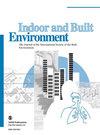Feasibility and performance analysis of a net-zero energy residential building in tropical climates: A case of Congo-Brazzaville
IF 2.9
3区 工程技术
Q2 CONSTRUCTION & BUILDING TECHNOLOGY
引用次数: 0
Abstract
Current building techniques in developing countries have become extremely critical. The net-zero energy concept has emerged as an essential strategy for minimising energy consumption and greenhouse gas emissions. However, its implementation, particularly in developing countries, remains a critical challenge. The purpose of this work is to assess the feasibility of achieving a net-zero energy building by combining energy-efficient design practices and renewable energy systems under the climatic conditions of the Republic of Congo. To achieve the stipulated objectives, DesignBuilder software was utilised for building modelling, energy load assessment and multiobjective optimisation of building energy efficiency measures, and the multicriteria energy optimisation was carried out using the HOMER tool. The optimisation results showed that the implementation of energy efficiency measures resulted in 39.15% energy savings, 43.45% thermal load savings and 55.68% discomfort hours reduction. Furthermore, the renewable energy system can provide 100% of the building’s energy load and a total savings of 3341.84 kgCO热带气候下净零能耗住宅楼的可行性和性能分析:刚果(布)案例
发展中国家目前的建筑技术已变得极为关键。净零能耗概念已成为尽量减少能源消耗和温室气体排放的基本战略。然而,这一概念的实施,尤其是在发展中国家的实施,仍然是一个严峻的挑战。这项工作的目的是评估在刚果共和国的气候条件下,通过结合节能设计实践和可再生能源系统,实现净零能耗建筑的可行性。为实现既定目标,利用 DesignBuilder 软件进行了建筑建模、能源负荷评估和建筑节能措施的多目标优化,并使用 HOMER 工具进行了多标准能源优化。优化结果表明,实施节能措施后,可节约 39.15%的能源、43.45%的热负荷和 55.68%的不适时间。此外,可再生能源系统可提供建筑 100%的能源负荷,每年可节约 3341.84 kgCO2eq。据估算,该系统的平准化能源成本为 0.256 美元/千瓦时,净现值成本为 20231 美元,而整个生命周期成本为 188.91 美元/平方米。
本文章由计算机程序翻译,如有差异,请以英文原文为准。
求助全文
约1分钟内获得全文
求助全文
来源期刊

Indoor and Built Environment
环境科学-工程:环境
CiteScore
6.40
自引率
25.00%
发文量
130
审稿时长
2.6 months
期刊介绍:
Indoor and Built Environment publishes reports on any topic pertaining to the quality of the indoor and built environment, and how these might effect the health, performance, efficiency and comfort of persons living or working there. Topics range from urban infrastructure, design of buildings, and materials used to laboratory studies including building airflow simulations and health effects. This journal is a member of the Committee on Publication Ethics (COPE).
 求助内容:
求助内容: 应助结果提醒方式:
应助结果提醒方式:


